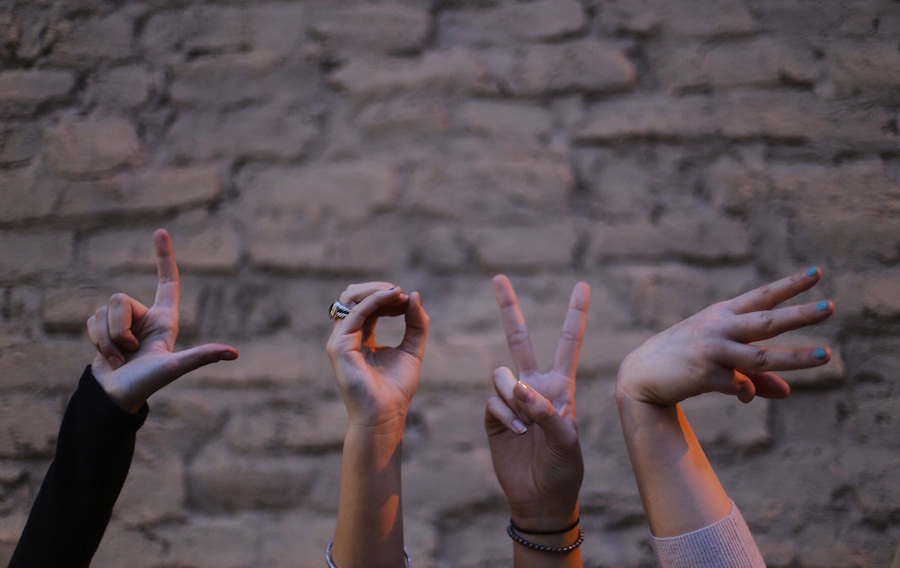
The instructions for passing the peace are pretty clear—and even written in the bulletin: un saludo cordial, mirando a los ojos. Which means, “a cordial greeting, looking into each others eyes.”
My first time at the Spanish-language service at my church, I thought I understood those instructions. I stood up and shook hands with the people seated around me. Each person murmured la paz del Cristo–The peace of Christ–as they shook hands with me.
Easy enough. I smiled cordially, looked them in the eyes, and repeated the phrase back to them. After two or three people, I sat down again. My shy self was a little relieved that the face-to-face time was over.
My duty done, I lifted up the bulletin, wondering what came next. Then I stopped.
Something weird was happening.
No one else was sitting down. No—everyone was wandering around the room like bees dancing in a hive, zooming from one person to another. People shook hands, they kissed cheeks, they hugged. Several people from across the room came over to me and passed me the peace, even though I had closed up shop.
For several minutes, I did a little jumping-jack dance where I started standing, then sat down again, feeling silly. Surely the greeting would end soon. Surely if I stood up now, I would be the last woman standing. Or maybe I seemed standoffish, sitting down? I half sat, half stood and wished I could hide someplace until the greeting dance ended.
It takes a while for even a small congregation to greet everyone in the room. I watched everyone swirl around me, wishing I had approached the peace of Christ differently. I realized that there are greetings, and there are greetings, and I had wandered into the second kind.
When Hospitality Keeps Surprising You
I’ve spent years of my life in Latin American cultures; greetings stuck out even in my first weeks of immersion. In one of my letters soon after I arrived in Argentina fifteen years ago, I wrote this: “I’m entranced with the Argentine people, who are warm to the extreme. The proper greeting is a kiss on the cheek, regardless of sex. After getting used to not sticking out my hand, I started loving that I got such a friendly welcome.”
That hive-dance I saw at church shouldn’t have surprised me; living in Argentina, the same sort of thing happened all the time. Arrive at a large birthday dinner? Everyone stands, forms an impromptu receiving line, and kisses you on the cheek. Coming in late to a gathering at a restaurant? Expect to go down the line of chairs saying hello to each person in turn. The more people arrive at once, the more comical the greetings seemed—a factory line of quick pecks and “holas”—twenty at a time—until my lips were worn out with air-kisses.
But if you don’t bother with greetings, people notice. If you don’t bother to say goodbye or goodnight, people notice. My Argentine friend Cami told me that when people don’t say hello to her, she wonders whether she offended them somehow.
So I’m surprised I was surprised by the greetings at church. And the more I see greetings as central to the congregation’s culture, the more I’ve seen them pop up everywhere, woven into the very fabric of worship.
So Many Ways of Welcome
After the opening prayer, new and returning visitors stand and introduce themselves by name, and the person leading the service greets welcomes them—calling out people that were too shy to stand up.
Minutes later, the children gather at the front of the room and say their names into the mike one by one. After each one, everyone answers back, “Hola, Henry,” or “Hola, Eileen.”
And informal welcome is constant: someone grabbing me a Bible in English when the leader begins to read from the Word. The pastor, rushing on his way to start the service, stops and gives me a hug, saying, “I am so glad you’re here.” An older man finds me a song sheet. And if someone comes to the service that doesn’t speak Spanish, a bilingual member sits next to them and translates.
An Example for Americans
Coming as a stranger for the first time to these services, being welcomed—formally and informally—deeply affects my heart.
And in a country where immigrants are often demonized and made to feel unwelcome, being given a warm welcome by immigrants is tremendously humbling.
I think about that before I started going to the Hispanic service at my church—which shares facilities and some activities with the Anglo population—when I’d see various members at the coffee cart, or in the English service. Can I be honest? I didn’t make an effort to look them in the eyes and give them a cordial greeting. I told myself they might not be interested in meeting me (despite my fluent Spanish and the fact that we’re brothers and sisters in Christ). I felt awkward and shy. I felt weird about the divisions between Latinos and Anglos at our church and in San Diego.
So I didn’t bother.
I’m not sure: is it culture that kept my eyes downcast? Is it culture that prevented me from walking over and giving the Latino members of my church a cordial greeting?
I look back and feel ashamed. I knew better, and I didn’t do better.
Hospitality Isn’t Optional
Being welcomed over and over into the Spanish-language church is changing my approach to hospitality. It’s not a nice thing for people who are good at it. It’s an imperative that acknowledges the humanity and value of every person. It’s the first step to confronting barriers like ethnicity, skin color, or language. It’s a petite cross that we should not neglect to shoulder.
I stay after the Hispanic service sometimes, and I watch as people leave. The parents kneel down by their children, and tell them to say goodbye to this person or that. Their children wiggle, ready to play or run or move on to the next thing, and their parents gently, kindly, insist.
Originally published at Rachel Pieh Jones’ site, Djibouti Jones.














 What happens when I panic
What happens when I panic